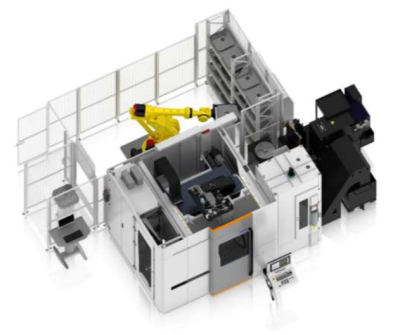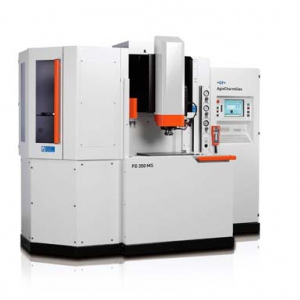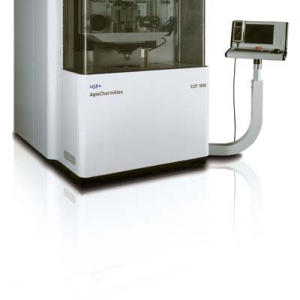Contact Details

GF Machining Solutions highlights two milling solutions to meet shops' needs for flexibility and robust performance. For five-axis machining with perfect workpiece roundness, superior surface quality and high material removal rates, the compact Mikron MILL P 800 U S demonstrated scalability with enhanced loading access. For high-precision productivity in three-axis vertical milling, the Mikron MILL P 900 – now available globally with the Heidenhain Touch Numerical Control (TNC) 640 – showed ideal capabilities for the mold and die industry.
The Mikron MILL P 800 U S allows shops to machine components fully on a single machine and eliminate transfer-related part errors, along with stacked tolerances, for enhanced quality of finished parts. This scalable solution is perfectly suited for automation, with a smaller footprint compared to the Mikron MILL P 800 U. This makes it the ideal machine when using two machines or more. It has a maximum loading capability of 1,000 kg (2,204.62 lbs) and is suitable for heavy roughing to fine finishing.
A newly redesigned enclosure provides easy, direct loading access at the back of the compact MILL P 800 U S, with additional robot-ready automation options in front of the machine, giving aerospace, automotive and general industry production a new way to expand production in less floor space. For aggressive material removal on the world's toughest materials, the latest high- dynamic cutting performance, integrated job and tool management and high-speed spindle design combines with high-tech process security for risk-free machining.
Gantry designs on all MILL P 800 U machines offer robust stability for machining tough materials such as titanium alloys over long periods of milling. Heidenhain TNC 640 and Siemens 840D controls ensure process safety, long tool life and overall production efficiency. Intelligent Spindle Monitoring (ISM) displays spindle vibrations in X, Y and Z axes. This complete picture of spindle movement helps reduce tooling costs, extends the life of the machine, heightens part quality and improves productivity.
All machines in the MILL P 800 U range are rConnect ready. This central communications platform enables manufacturers to maximize their productivity and their control over production. Live Remote Assistance (LRA), process improvement modules, predictive maintenance and machine monitoring improve machine uptime and add more flexibility on the shop floor. LRA allows for customer-authorized remote assistance via real-time connection of machines to GF Machining Solutions. With LRA, either the manufacturer using the system or a GF Machining Solutions technician can conduct remote diagnostics and inspections.
The Mikron MILL P 800 U S will be offered to customers as part of a complete newly designed service package. They can expect a full support with one supplier for the whole cell including automation. On top of that, they will receive extra hours of support, quick access to experts to get the machine on track up to 12 times faster, remote support using the latest digital technologies and advanced diagnostics on the spindle and the robot's motions. Further advantages for customers include the worldwide spindle exchange service within 24 hours, as well as original parts and upgrade to the latest software, reducing downtime significantly.
The Mikron MILL P 900 – Now available with TNC 640
The new Heidenhain Touch Numerical Control (TNC) 640 on the Mikron MILL P 900 answers customers' need for greater flexibility. The control's intuitive, user-friendly interface offers a wide range of functions designed to ensure great reliability. Its touch screen allows the operator to navigate through the control quickly and easily, which ultimately frees up the operator for other value-added tasks. Multiple machine optimization modules and smart machine features increase productivity and reduce energy consumption.
The robust MILL P 900 features a polymer concrete machine base that delivers extreme dynamic stiffness, with the thermal management, contour accuracy and precise positioning to create superior surface finishes. A symmetrical portal design and effective chip management heighten operational efficiency.
To reduce cycle times, the machine packs a high-performance, high-speed 20,000-rpm Step-Tec spindle that delivers 120 Nm of torque. The spindle features an advanced V3D vibration monitoring system with three vibration sensors that visualize spindle performance completely and accurately. An available 36,000 rpm spindle delivers the axial stability to create the superb surface finishes necessary for high-end molds with tight tolerances for finish and size.
The MILL P 900 includes a 30-position tool magazine and automatic tool changer, with a 60- position option available. The tool changers deliver 4.2-second tool changes with a 7.4-second chip-to-chip time. Easy access via a side door enables operators to change out tools with ease.
Available integrated automated pallets handle maximum payloads of 200 kg (440 lbs). Chip- control options, lights-out production capabilities and GF Machining Solutions’ rConnect process- monitoring technology all contribute to optimize overall machine utilization and output on the MILL P 900.
Related Glossary Terms
- alloys
alloys
Substances having metallic properties and being composed of two or more chemical elements of which at least one is a metal.
- dynamic stiffness
dynamic stiffness
Measure of a machining system’s ability to dampen vibration from a forced input. If the dynamic stiffness of a system is not sufficient to dampen vibration, chatter occurs. See static stiffness; stiffness.
- gang cutting ( milling)
gang cutting ( milling)
Machining with several cutters mounted on a single arbor, generally for simultaneous cutting.
- milling
milling
Machining operation in which metal or other material is removed by applying power to a rotating cutter. In vertical milling, the cutting tool is mounted vertically on the spindle. In horizontal milling, the cutting tool is mounted horizontally, either directly on the spindle or on an arbor. Horizontal milling is further broken down into conventional milling, where the cutter rotates opposite the direction of feed, or “up” into the workpiece; and climb milling, where the cutter rotates in the direction of feed, or “down” into the workpiece. Milling operations include plane or surface milling, endmilling, facemilling, angle milling, form milling and profiling.
- milling machine ( mill)
milling machine ( mill)
Runs endmills and arbor-mounted milling cutters. Features include a head with a spindle that drives the cutters; a column, knee and table that provide motion in the three Cartesian axes; and a base that supports the components and houses the cutting-fluid pump and reservoir. The work is mounted on the table and fed into the rotating cutter or endmill to accomplish the milling steps; vertical milling machines also feed endmills into the work by means of a spindle-mounted quill. Models range from small manual machines to big bed-type and duplex mills. All take one of three basic forms: vertical, horizontal or convertible horizontal/vertical. Vertical machines may be knee-type (the table is mounted on a knee that can be elevated) or bed-type (the table is securely supported and only moves horizontally). In general, horizontal machines are bigger and more powerful, while vertical machines are lighter but more versatile and easier to set up and operate.
- numerical control ( NC)
numerical control ( NC)
Any controlled equipment that allows an operator to program its movement by entering a series of coded numbers and symbols. See CNC, computer numerical control; DNC, direct numerical control.
- stiffness
stiffness
1. Ability of a material or part to resist elastic deflection. 2. The rate of stress with respect to strain; the greater the stress required to produce a given strain, the stiffer the material is said to be. See dynamic stiffness; static stiffness.
Additional Products from GF Machining Solutions
Pagination
- First page
- Previous page
- 1
- 2
- 3
- 4
- 5
- 6





 PRODUCTS
PRODUCTS

